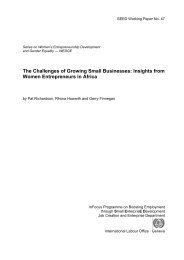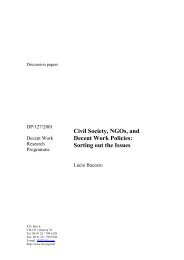Nepal Trafficking in Girls With Special Reference to Prostitution: A ...
Nepal Trafficking in Girls With Special Reference to Prostitution: A ...
Nepal Trafficking in Girls With Special Reference to Prostitution: A ...
Create successful ePaper yourself
Turn your PDF publications into a flip-book with our unique Google optimized e-Paper software.
A Rapid Assessment<br />
II. Methodology<br />
2.1 Rapid Assessment<br />
This study is based on the Rapid Assessment (RA)<br />
methodology developed by the International<br />
Labour Organization/International Programme on the<br />
Elim<strong>in</strong>ation of Child Labour (ILO/IPEC) and the<br />
United Nations Children’s Fund (UNICEF). The purpose<br />
of the Rapid Assessment is twofold: <strong>to</strong> understand<br />
the situation of traffick<strong>in</strong>g <strong>in</strong> children <strong>in</strong> <strong>Nepal</strong><br />
with special reference <strong>to</strong> prostitution and <strong>to</strong> suggest<br />
feedback for design<strong>in</strong>g <strong>in</strong>tervention strategies for combat<strong>in</strong>g<br />
this situation.<br />
Comb<strong>in</strong><strong>in</strong>g both quantitative and qualitative data<br />
gather<strong>in</strong>g <strong>to</strong>ols, the Rapid Assessment is aimed at<br />
obta<strong>in</strong><strong>in</strong>g <strong>in</strong>-depth knowledge of a given phenomenon<br />
with<strong>in</strong> only three months. Secondary <strong>in</strong>formation has<br />
been obta<strong>in</strong>ed from available sources such as reports,<br />
newspaper articles, and sem<strong>in</strong>ar papers. Primary <strong>in</strong>formation<br />
consists of both quantitative and qualitative<br />
data that has been generated through <strong>in</strong>terviews<br />
and field surveys, with emphasis on qualitative data<br />
that may shed light on the often hidden aspects of traffick<strong>in</strong>g<br />
for sexual exploitation.<br />
A Rapid Assessment is a sequenced research<br />
process, with one set of <strong>in</strong>formation feed<strong>in</strong>g <strong>in</strong><strong>to</strong> the<br />
next research activity. Cross-check<strong>in</strong>g has taken place<br />
cont<strong>in</strong>uously, through <strong>in</strong>terviews and discussions, and<br />
<strong>in</strong> cases of discrepancies, more <strong>in</strong>formation has been<br />
sought <strong>in</strong> order <strong>to</strong> verify it through a process of triangulation.<br />
In some such cases, repeat <strong>in</strong>terviews were<br />
conducted.<br />
A six member research team composed of two<br />
men and four women were given a seven-day <strong>in</strong>tensive<br />
tra<strong>in</strong><strong>in</strong>g course on such issues as RA methodology,<br />
def<strong>in</strong>itions of traffick<strong>in</strong>g, socio-economic and<br />
political situation of the study sites and ethical issues<br />
when do<strong>in</strong>g research with children. The <strong>in</strong>dividual<br />
questionnaire was pre-tested twice <strong>in</strong> Kathmandu, with<br />
the support of three women who had been trafficked<br />
for sexual exploitation. Other resource persons <strong>in</strong>clude<br />
experts from Central Department of Population Studies,<br />
Child Workers <strong>in</strong> <strong>Nepal</strong> Concerned Centre<br />
(CWIN), Harvard University, ILO/IPEC, and the<br />
<strong>Nepal</strong> police also provided feedback <strong>in</strong> the <strong>in</strong>dividual<br />
structured questionnaire.<br />
2.2 Target Population<br />
The populations targeted for <strong>in</strong>vestigation were<br />
vulnerable girls and girls and women who had been<br />
trafficked for sexual exploitation, as well as those<br />
engaged <strong>in</strong> prostitution <strong>in</strong> <strong>Nepal</strong>. In this study, the<br />
respondents have been classified as follows:<br />
I. The group of vulnerable girls (not yet trafficked)<br />
is comprised of girls below the age of 18<br />
(N=100). These were identified through the snowball<strong>in</strong>g<br />
method dur<strong>in</strong>g the first round of <strong>in</strong>terviews with<br />
NGOs and other key <strong>in</strong>formants. Vulnerability, as<br />
def<strong>in</strong>ed <strong>in</strong> the box below, was used as the criteria for<br />
selection.<br />
Vulnerability<br />
Immediate family environment<br />
• Fragile family situation (alcoholism, unemployment,<br />
sexual abuse, domestic violence)<br />
• Poverty and very low <strong>in</strong>come<br />
• Children not enrolled <strong>in</strong> school<br />
• Sisters already trafficked<br />
• Illness among parents<br />
The community<br />
• Wrong perceptions about the dest<strong>in</strong>ations<br />
perpetually reproduced through traffick<strong>in</strong>g<br />
networks<br />
• Anecdotal evidence of school teachers, politicians<br />
be<strong>in</strong>g <strong>in</strong>volved <strong>in</strong> traffick<strong>in</strong>g<br />
• Abusive school teacher<br />
• Neighbours already trafficked<br />
• No employment opportunity for adolescents<br />
II. The group of girls trafficked for sexual exploitation<br />
<strong>in</strong>side <strong>Nepal</strong> is comprised of girls under 18<br />
years of age <strong>in</strong>volved <strong>in</strong> commercial sexual exploitation<br />
<strong>in</strong> hotels, restaurants and roadside sheds, etc when<br />
<strong>in</strong>terviewed (N=13).<br />
III. The f<strong>in</strong>al target group consists of returnees,<br />
i.e. of trafficked girls both under and above 18 years<br />
(but who were trafficked when they were below 18<br />
years of age), who are currently liv<strong>in</strong>g <strong>in</strong> rehabilitation<br />
centres or who have already been re<strong>in</strong>tegrated<br />
<strong>in</strong><strong>to</strong> their families, communities, and/or society at large<br />
(49 + 11 + 12 = N= 72). In this study, emphasis has<br />
been given <strong>to</strong> girls <strong>in</strong> rehabilitation centres (i.e. rehabilitated<br />
girls, N=49). Yet, the category of returnees<br />
further <strong>in</strong>cludes trafficked girls who have been re<strong>in</strong>-<br />
9

















